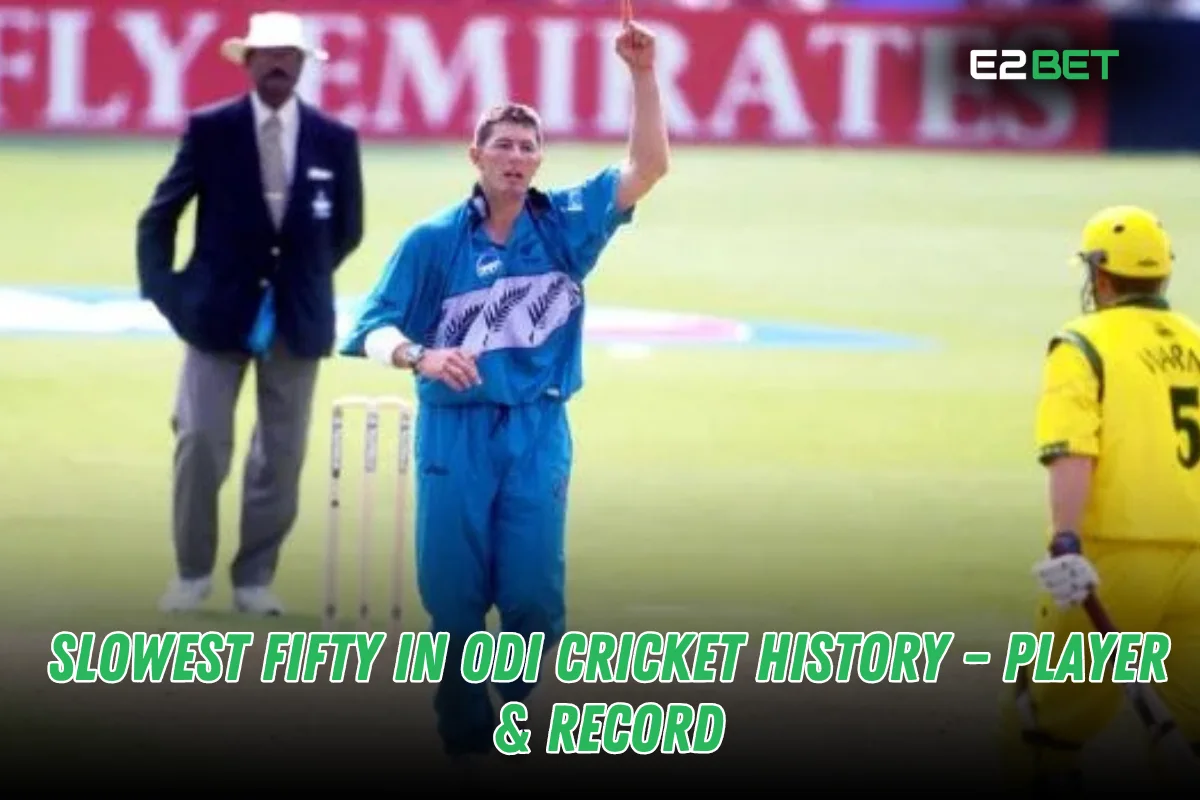Cricket is a game full of surprises, where records are made and broken in every era. While most fans get excited about the fastest centuries and highest scores, there’s another unique milestone that sparks curiosity—the slowest fifty in ODI history.
Yes, not every inning is about explosive stroke play. Some fifties are painstakingly slow, driven by match situations, defensive strategies, or even just survival. This article will dive into who scored the slowest fifty in ODI cricket, the context behind it, and why some players adopt a slow approach in one-day internationals.
Understanding Slowest Fifties in ODI Cricket
Before revealing the slowest 50 in cricket history, let’s first understand what makes a fifty slow in ODIs:
- A batsman reaches 50 runs after facing an unusually high number of balls.
- Factors like pitch conditions, disciplined bowling attacks, or match-saving efforts contribute to slow scoring.
- While some players are naturally defensive, others play cautiously in response to game pressure.
In an era of fast-paced ODI cricket, scoring a slow fifty is rare. However, in the past, defensive batting in ODIs was more common.
The Name of the Player Who Scored the Slowest Fifty in ODI
The record for the slowest half-century in ODIs belongs to Geoff Allott, a former New Zealand cricketer.
- Balls Taken for Fifty: 162
- Match: New Zealand vs. South Africa
- Event: 1999 Cricket World Cup
- Venue: Edgbaston, England

Allott, who was primarily a bowler, unexpectedly played an innings that lasted much longer than expected. His knock remains a benchmark for the slowest 50 in one-day internationals.
Match Details and Analysis
Let’s break down how and why Geoff Allott scored the slowest fifty in ODI history:
- Opposition: South Africa, known for its lethal bowling attack.
- Match Situation: New Zealand was struggling, and Allott had to survive.
- Bowling Attack: Shaun Pollock, Allan Donald, and Jacques Kallis were all in form.
- Result: New Zealand lost, but Allott’s innings became historic.
This innings is an example of how defensive batting in ODIs can sometimes lead to unexpected records.
Top 5 Slowest Fifties in ODI Cricket History
While Geoff Allott holds the record for the slowest 50 in ODI cricket, other players have also played unusually slow innings:
| Player | Balls Taken | Opponent | Year |
|---|---|---|---|
| Geoff Allott (NZ) | 162 | South Africa | 1999 |
| Sanath Jayasuriya (SL) | 100 | India | 2005 |
| Sunil Gavaskar (IND) | 94 | England | 1975 |
| Geoffrey Boycott (ENG) | 92 | Australia | 1980 |
| Hashim Amla (SA) | 89 | India | 2015 |
These players, despite their defensive approach, showed resilience and patience.
Why Do Some Players Score Slow Fifties?
There are several reasons why a batsman might end up scoring the slowest fifty in ODI matches:
- Defensive Strategy: Some batsmen play cautiously to build a foundation.
- Bowler Dominance: Facing high-quality bowlers can make scoring difficult.
- Match Situation: If the team is struggling, a batsman may focus on occupying the crease.
- Pitch Conditions: Slow pitches make it harder to play attacking shots.
Many players adapt their approach based on these factors, leading to some of the slowest 50s in ODI cricket.
Slowest Fifties vs. Slowest Centuries
There’s a big difference between the slowest 50 in cricket and the slowest 100 in ODIs:
- The slowest ODI century was scored by David Boon (Australia) in 166 balls.
- A slow half-century is still acceptable in some situations, but taking too long for a century is extremely rare.
The contrast between these records highlights the changing nature of ODI cricket.
Impact on Team Performance
Is the slowest 50 in ODI matches always bad? Not necessarily.
-
Positive Impact:
- If a team is struggling, a slow fifty can stabilize the innings.
- Helps in building partnerships and avoiding batting collapses.
-
Negative Impact:
- In a high-scoring game, a slow ODI fifty can put pressure on the team.
- Can result in losing momentum if not timed properly.
The fast-paced nature of modern ODIs has made slow batting performances less common.
Famous Players Known for Slow and Defensive Batting
Some cricketers have gained a reputation for playing defensively and scoring slow fifties:
- Geoffrey Boycott (England) – Famous for grinding out runs.
- Sunil Gavaskar (India) – Known for his careful approach.
- Hashim Amla (South Africa) – Played with calculated risk.
These players often relied on defensive techniques rather than explosive hitting.
Lessons to Learn from the Slowest Fifties
The slowest fifties in ODI cricket teach us valuable lessons:
- Patience is a crucial skill in cricket.
- Not every innings needs to be aggressive—situational awareness is key.
- Defensive techniques are still relevant despite the rise of T20-style batting.
Conclusion
Cricket is a game where both speed and patience play a role. While fastest centuries are celebrated, the slowest 50 in cricket history is equally interesting.
Geoff Allott’s 162-ball fifty may never be repeated in modern ODIs, but it serves as a reminder that cricket is not just about boundaries—it’s also about survival, adaptability, and strategy.
FAQs
Q1. Who scored the slowest fifty in ODI cricket?
Ans: Geoff Allott (New Zealand) holds the record, scoring 50 off 162 balls.
Q2. What is the slowest century in ODI history?
Ans: David Boon (Australia) scored the slowest ODI century in 166 balls.
Q3. Why do some batsmen play slow in ODIs?
Ans: Factors like pitch conditions, bowling attack, and match situations affect scoring pace.
Q4. Is scoring slow always bad in cricket?
Ans: Not always. Sometimes, defensive batting helps a team avoid defeat.
Q5. How has ODI batting changed over the years?
Ans: The influence of T20 cricket has made slow innings less common in modern ODIs.